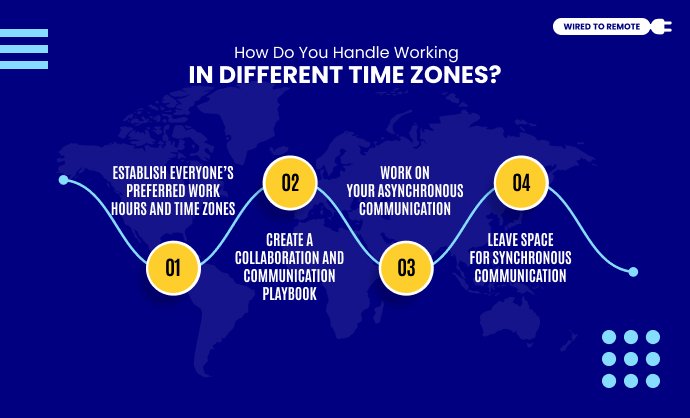Working with teams scattered across the globe can be somewhat challenging. So, how do you handle working in different time zones? While working remotely has benefits, working with colleagues in different time zones is tricky.
Despite time constraints, more and more people are interested in working remotely. So, it is highly possible that colleagues working across time zones and borders will become the norm.
After all, having teams working from different time zones is great – since it gives your company a whole workday spanning 24 hours with the best skills from across the globe. Moreover, in such cases, teams can work together to meet urgent deadlines without anyone working late-night shifts or overtime.
In short, you can get so much done without compromising quality – but this works out only when you communicate and collaborate effectively. So, let’s talk about how you could do that – if it worked for me, it would also work for you!
In this article, I have discussed the challenges I faced while working with professionals across the globe. Of course, I’ve also talked about how I was able to work with remote teams in different time zones – with these strategies, you will be able to communicate and collaborate better.
Stay tuned!
The BIGGEST Challenges Of Working With Teams In Different Time Zones:

So, how do you handle working in different time zones? What’s the truth? Is it as easy as it sounds?
I don’t think so!
Before I can talk about the solution, let’s look at all the challenges that different time zones can pose for remote teams.
TBH, coordination is not a big deal when time zones differ by a few hours. But things start getting tricky when your project manager works from the United States and your internal team sits in India. India is ahead of the United States by 10 hours and 30 minutes – in that case, coordinating schedules can be complex.
I have worked with people across the globe, and after 7 years in the content marketing industry, these are the primary issues that I faced due to differing time zones.
- The absence of clarity amongst team members about each other’s time zones can lead to missed deadlines and operational delays.
- Poor communication leads to a fall in the quality of deliverables and creates additional work for all parties involved.
- Tasks allocated to multiple people become difficult to execute without the right tools or system to communicate and collaborate.
- Team members often feel disconnected and isolated. They also feel not aligned with the culture of the company, increasing the chances of quitting or poor performance.
- When employees communicate and work beyond their regular hours, their work-life balance impacts. A poor work-life balance can impact employees’ personal lives, harming their professional productivity and growth.
How do you maintain a work-life balance while working remotely?
1. Create a routine/schedule and follow it consistently.
2. Mark yourself offline and online as per your availability on communication platforms.
3. Make plans after work and balance your post-work exhaustion.
4. Don’t move or cancel meetings.
5. Go on walks.
How Do You Handle Working In Different Time Zones?

Yep, those are the biggest challenges of working with people in different time zones. But that doesn’t mean you will avoid working with global remote teams – it is a fun way to boost your professional networking (an added perk, I call it)!
So, how do you handle working in different time zones?
Here’s what I am about to suggest: you cannot solely depend on tools to ensure smooth communication. Apart from technology, there are some little things you need to do from your end. Once you make those changes and use the right technology, you cannot stop.
So, this worked for me – here’s a complete breakdown of how I managed to work with people in different time zones.
1. Establish Everyone’s Preferred Work Hours And Time Zones:
While working remotely with people in multiple time zones, the most important rule is: be respectful, empathetic, and mindful.
Nobody should be forced to be available at all hours – the whole I always need to be online should be a no-no from the beginning. You risk being burnt out if you don’t establish your professional boundaries, especially about your availability. This, in turn, negatively impacts the whole team’s productivity, collaboration, and creativity.
How To Create Healthy Professional Boundaries For All Teams?
1. Encourage everyone to establish their working hours.
2. Update your time zone on Slack or Teams.
3. Use autoresponders.
4. Use a shared calendar on Google.
5. Create a safe space for conversation about communication windows and professional boundaries.
I have always established my time zone and work hours from the onset. It is vital to respect everyone’s work hours – but it is more important to respect their DND (do not disturb) hours.
You can update your hours on Teams, Slack, or whatever channel your company uses. Moreover, it is difficult to track everyone’s time zones without technology – while some work from home, others like me are digital nomads.
In addition, you can also make the most of autoresponders like out-of-office emails and a shared calendar on Google to ensure that nobody disturbs you when you are on leave.
2. Create A Collaboration And Communication Playbook:
You should clearly outline your guidelines for collaboration tools and communication policies and share the same with all involved parties during onboarding. This is mostly applicable to employees who work in freelancing or contractual setups.
But for employees, companies typically share their guidelines during onboarding. It is imperative that you read these carefully and ask questions when you are joining a company.
What Should A Communication Playbook Include?
1. Communication channels and how to use them.
2. Project management guidelines and tools.
3. The team you will work with - their work hours and time zones.
4. The operational workflow - who assigns tasks, who executes them, etc.
It is vital to have all the information you need about a company’s communication channels and project management tools.
Figure out: Do you have to attend video calls for daily logins? Do your colleagues use Outlook for sharing resources or depend on Slack?
Moreover, check out what project management tools everyone uses to improve remote collaboration. Typically, team leaders use these tools to assign tasks, add resources, and set deadlines. You should have everything at your disposal to start working once your work hours begin – no matter the time zone or actual time of the day.
3. Work On Your Asynchronous Communication:
Asynchronous communication is standard for anyone working remotely, especially professionals from multiple time zones. In most cases, such communication occurs when you are out of sync, that is, not at the same time.
So, what I am trying to say is while working remotely, people send messages – but without expecting any immediate response. Once professionals have time to check their Teams, they can review messages and reply. This appears to help employees work more productively and autonomously without interruptions.
But then nobody talks about the real problem.
For instance, you sent a message that is confusing or lacks clarity. The recipient may read the same after 10 hours during their work hours. Then, the recipient will respond asking for clarity and again wait till it’s your time to respond.
So, a whole day or more could go by without any work getting done – and that is not how any high-performing remote team communicates or collaborates.
How Can You Improve Asynchronous Communication?
• Plan ahead - always
• Communicate deadlines clearly.
• Emphasize well-written communication.
As a result, before you can send a text, ask yourself:
- Does the recipient have everything at their disposal to finish the next step?
- Can you make everything more transparent?
- Is there any document that you can attach for facilitating work?
- Does the recipient have access to the documents you are sharing?
4. Leave Space For Synchronous Communication:
Synchronous communication is basically any communication that takes place between working professionals in real time. It is essential – and has several benefits:
- Improves team building and bonding.
- Creates space for celebrating important milestones.
- Allows everyone to brainstorm and share input.
So, I think while 75-80% of your primary communication should be asynchronous, leave 25-20% for real-time synchronous communication.
The Best Options For Synchronous Communication Are:
• Weekly check-ins.
• Shout-outs, kudos, and appreciation messages.
• Watercooler conversations - but on Teams.
• Real-time video calls.
In addition, synchronous communication will help to bring the team together with efficient and productive communication.
Moreover, you can also consider using tools like ‘Time and Date,’ and ‘World Time Buddy.’ These tools will make holding meetings easy and convenient. You just need to plug in your current locations and get help from the tool to calculate cross-over hours to work.
How Do You Handle Working In Different Time Zones? Easy-Breezy!
So, how do you handle working in different time zones? It’s easy, breezy, and convenient!
Working with remote teams across different time zones will become easy once you start following the tips I have outlined above. Employees can focus well and, most importantly, work cohesively to deliver results.
It begins with establishing your work hours and time zone – so that you can effectively communicate without crossing any major boundary. Next, just start opting for asynchronous communication while leaving space for synchronous communication.
If there’s something else that you find works for you, feel free to come back and share those ideas with us. Our aim is simple – to simplify remote work, eliminating the issues plaguing digital nomads and remote professionals.




Leave A Comment